Emilio M. Morales MSCE
EM2A Partners & Co
Quezon City, MM
(Philippines)
Toshio Ono
MMLRT Consultants
Tokyo, Japan
ABSTRACT
A support Pier (Pier 161) for a Light Rail line being constructed for the Metro Manila Light Rail Project encountered large settlements after the installation of the Precast Deck Girders. This pier supports bridge crossing across the San Juan River with a total span of sixty (60) meters. This Pier is supported on six (6) 1500 mm diameter bored piles designed to extend down to 17 meters or socketed into bedrock at least 2.0 meters based on design requirements. The structure started to settle during the erection of the superstructure when the dead load reached about 700 metric tons. Total settlement was about 42 mm when the erection was halted at a dead load of about 1600 metric tons.
The pier was designed to carry a maximum total load of about 2100 metric tons (DL + LL). Subsequent subsurface investigation conducted by our office indicated that the bored piles were terminated prematurely and were not socketed into bedrock as originally specified. The Bored pile tips were resting on approximately 150 mm of soft to very soft clay and highly weathered bedrock, which is partly natural soil and drill cuttings. Several remediation procedures were considered but finally, Jet grouting was selected .
This paper discusses the problems associated with the settlement and the ensuing solution using Jet Grouted Piles.
INTRODUCTION
The subsurface soils, being natural deposits, tend to introduce unexpected variability in the subsoil that is not revealed by the soil exploration or during construction. This situation could lead to costly delays in the process. In addition, errors in construction of foundations could lead to serious problems that would require costly intervention.
This paper addresses the foregoing real world problems, which have been solved with the use of innovative foundation technologies.
SETTLEMENT OF BORED PILE FOUNDATIONS
A pier supporting 60 m long span Precast concrete Box Girders for a light rail transit line crossing a river experienced significant settlement immediately upon placement of the Girders (Dead Load). The substructure consists of 6 X 1500 mm Diameter bored piles supporting a 1500 mm thick RC Pile cap.
The settlements were alarming as the pier was supported on bored piling that is supposed to be socketed at least 2000 mm into bedrock. This initial settlement of 36mm caused concern and was continuing progressively until loading and other construction activities were halted. By that time, a total of 45.7mm maximum settlement had already resulted. Fig. 1 shows the settlement profile.
The erection subcontractor for the Precast Concrete Box Girder segments specified a maximum short-term settlement of 30mm and a total maximum long-term settlement of 45mm. Clearly, the recorded initial settlements have already actually violated these values and the Box Girders have to be raised by jacking in order to level the Girders.
All construction activities were halted at this juncture and intermediate heavy steel supports were placed near the Pier support in case further settlements are experienced. These supports were also used as the reaction platform for the jacking equipment.
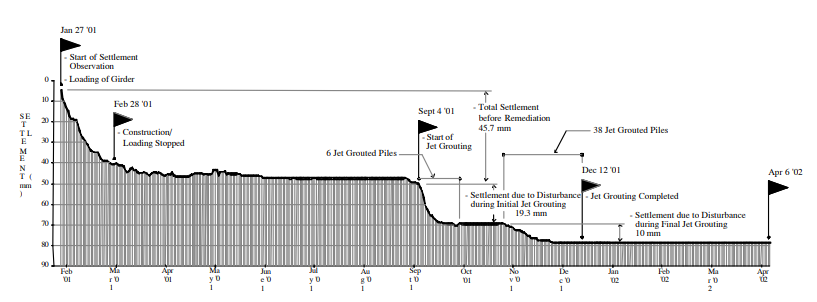
Our organization was engaged by the Contractor initially to undertake an investigation of the subsurface to determine the possible cause/s of the settlement which was very alarming considering that this particular Pier is supported on six (6) large diameter Bored Piles on a massive pile cap.
The following are the standard design details of the Bored Pile foundation for the project:
Number of Bored Pile N = 6
Diameter of Bored Pile D = 1500 mm
Length as installed L * = Varies
Theoretical Allowable Load bearing Capacity (MT) *
As designed Capacity:
CStatic = 515 MT/pile
CEqk = 799 MT/pile
*Based on Piling Contractor’s Bored Piling record.
*From Capacity Calculation Sheets.
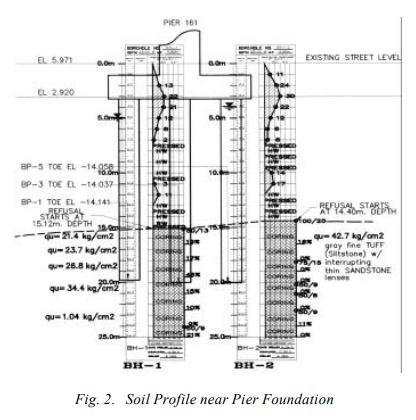
As can be seen, refusal was only encountered at a depth of 15.12 meters and 14.40 meters below existing Natural Ground Line.
Soil Profile taken across BH-1 and BH-2 as shown in Fig. 2 indicate the slightly sloping bedrock layer.
In addition to the foregoing and at a much later date, coring at the center of the Bored Piles indicated the actual gaps between the Pile Toe and the Bedrock.
A tabulation of the initial drilling results when matched against the as assumed installed depth is shown below in Table 1.
Table 1. Tabulated Values of Bored Pile Lengths and computed gap between Pile Toe and Bedrock.
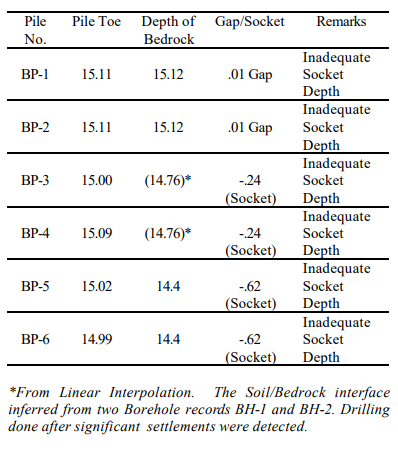
As can be seen from the above figure , two of the Bored Piles (BP-1 and BP-2), even when based on the assumed installation depth, were literally resting on very soft clay and the rest were socketed only about 0.24 meters into the possibly highly weathered Soil/Bedrock Interface.
The remaining gap is about 10mm after the recorded settlements (based on this assumed installation Depth). Thus, it was possible that the clays have been squeezed out at some locations resulting in the Bored Piles resting partly on the Bedrock and partly on very soft clay.
It was suspected that the actual gap between some of the Bored pile tips and the bedrock are as thick as 150 mm before settlements occurred as detected from later corings done at the center of the bored piles as shown in Fig. 3.
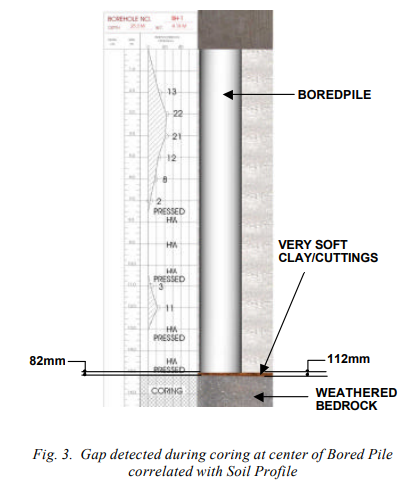
Thus, the heavily loaded Bored Piles were either resting on very soft clay or on relatively weathered Bedrock very near the Soil Bedrock interface without adequate socketing.
Geology of the Site
The site across the San Juan River in San Juan, Metro Manila is generally underlain by the Guadalupe Tuff Formation (GTF), a massive suite of soft Tuffaceous Volcanic rocks. The sedimentary rocks were formed from water laid volcanic sediments thousands of years ago. The Guadalupe tuff formation is characteristically soft Quaternary Volcanic rocks.
The Pier Foundations that settled supported the Eastern end of the 60 m long girders spanning the San Juan River atop the Lambingan Bridge.
Overburden soils are relatively poor to very poor below 7 meters and consist of clays and silts down to about 15.0 meters and sloping towards the Lambingan River. The upper layers are essentially sands, which have been precompacted by traffic and various construction activities in the vicinity.
Underlying this thin overburden sandy layer is a soft to very soft layer of clays and silts which needed to be bypassed by Bored Piles to transfer the foundation loads to more competent rock.
The RQD values below the soil bedrock interface showed relatively fair values of 19% and 16% respectively.
Average Bedrock Unconfined Compressive Strengths are about 20.0 kg/cm2 near the Bored Pile Tip characteristic of soft volcanic sedimentary rock known as the Guadalupe Tuff Formation (GTF).
What Caused the Settlement?
The Bored Piles were not adequately socketed as required and were partly resting on very weak materials. During the Bored pile installation, it was possible that boulders and large cuttings were encountered which resulted in erroneous interpretation that the Bedrock level had been penetrated. No reliable report as to what actually happened could be obtained.
As stated earlier, the specification called for a minimum socket depth of 1.0m to 2.0m into bedrock. No clear or reasonable explanation could be given as to why the Bored Piles were installed short of the target depth. It can only be assumed that this was overlooked during the installation and the hole was not cleaned or inspected at all.
Since the Bored piles were terminated prematurely, and were mainly resting on very soft clays or cuttings, settlement had to ensue. This was the primary cause of the relatively large settlement that was experienced at this particular Pier location.
Remediation Measures
Immediately upon detection of on-going settlements, formal settlement monitoring and recording was started 27 January 2001. Because of the continuing high rate of settlement, construction loading was halted on February 28, 2001. Heavy Structural Steel scaffolding was placed to support the Girders and Jacking relevelled the Girders. Still settlements continued but at a reduced rate resulting in a total of 45.7mm settlement of the Pile Cap.
The ensuing check borings (Fig. 1 and Fig. 2) verified that the Bored Pile tips were resting on very soft soils or on highly weathered bedrock.
Several remediation measures were discussed and these were Narrowed down to two feasible technologies:
- Micropiling
- Jet Grouting (JGP)
The Micropiling was finally ruled out due to the large lateral forces involved, which would have required extensive use of reticulated Micropiles and extensive drilling through the heavily reinforced 1.5 meter thick pile cap. The installation alone would unavoidably cause cutting of numerous rebars in critical areas of the pile cap.
The Jet Grouting solution was finally selected because it offered a far better assurance of stability during seismic loadings and also reduced damage to the pile cap rebar. As shown in Fig. 4 the solution consisted of providing a Jet Grouted Secant Wall around the footprint of the Pile Cap and at several interior locations as shown in the plan.
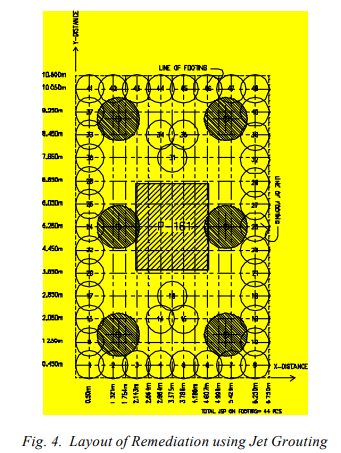
This Jet Grouted Curtain Wall in Secant Pile arrangement would assure full assumption of the load from the Bored Piles while at the same time increasing resistance to sliding and overturning, because of its large footprint area and “Secant wall” arrangement.
The secant wall arrangement also had the beneficial effect of compensating for the low bending resistance of the JGP by behaving as a wall providing lateral support for adjacent elements. The Final installation resulted in the use of 44 pieces of JGP elements including two clusters of 3 JGP in the interior. These were intended to fully take up the load on the bored piles during service loading effectively relieving the bored piling of any load.
A cutaway section of the remediation is shown below as Fig. 5.
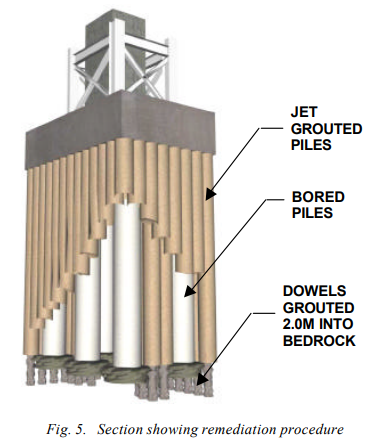
A set up of the equipment underneath the Girders is shown in Fig. 6 and 7. The equipment is a Double tube Jet Grouting System with Grout injected through a side jet protected by a compressed air shroud.
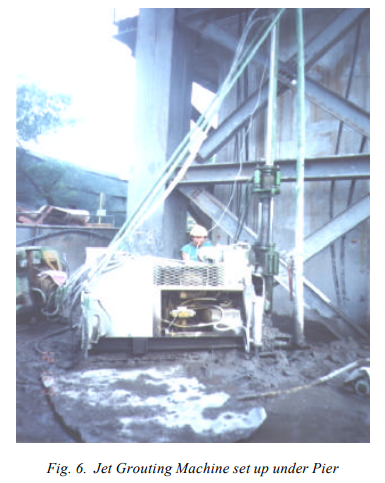
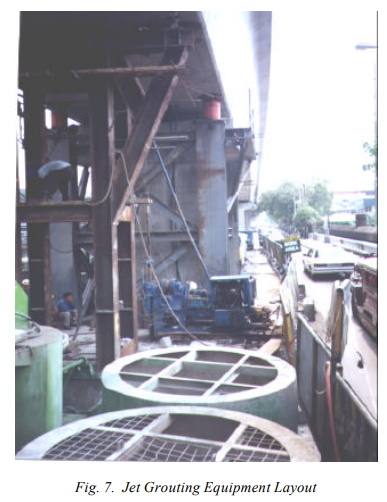
In addition, each of the Jet Grouted Piles were reinforced at the center by 25mm Ø rebars which were inserted by redrilling the Jet Grouted Piles (JGP) after it has sufficiently cured, and extending this 2.0 meters beyond the Soil/Bedrock interface into competent Bedrock. The drilled holes and dowel bars were subsequently regrouted effectively doweling each JGP into the Bedrock.
Expansive admixture and higher strength mix was used to grout the rebar to the Pile Cap. This provided extra shear capacity over and above that provided at the Pile Cap/JGP Interface and also at the JGP/bedrock interface further increasing sliding resistance.
The settlement record for the project is shown in Fig. 3. The milestones are flagged. It can be seen that with the initial Jet Grouting, additional settlement of 19.3mm was experienced due to further disturbance of the weak soils near Bored Pile Tips, although care was exercised to reduce such disturbances to the minimum by initially drilling far from the Bored piles. The Girders had to be releveled again by Jacking.
The Jetting was halted to allow for the curing of the Soilcrete and also because questions were raised about the effectiveness of the technology given the additional settlements. After Field trials were done to verify the effective diameter of the JGP and the Guaranteed Compressive Strength it was shown that the Test Piles satisfied or even exceeded project requirements. Subsequently, Jet Grouting was restarted for the final Jet Grouting of 38 Piles on November 1, 2001. Only 10mm additional settlements were recorded. The Jet Grouting was completed on December 12, 2001. By this time settlements have tapered off and allowed work to be restarted on the superstructure including the laying of ballast stone.
In addition, the Project consultants required that the existing Bored piles be redrilled at the center to allow for the insertion of Grouting Pipe in order to grout the pile tip. Jetting was done to wash away the remaining soft clay on the now hanging bored piles and jet grouting with rich grout was done. This would ensure that once the “Soilcrete” had cured, the Bored pile tips would be resting on solidified ground. This was accomplished after the initial JGP installation and was done initially in areas where the JGP have substantially cured and attained full strength.
This added measure partially restored the load carrying capacity of the bored piles allowing it to contribute to the overall load capacity rather than just hang as “deadweight” from the pile cap.
The solidification at the tip of the Bored pile is shown in the figure below:

No further settlements have been recorded despite the placement of ballast and rail tracks as well as other hardware and the remediation was considered successful.
Lessons Learned
Careful monitoring of the Bored Pile installation is very important to ensure the integrity of the Bored Pile foundation including adequate and proper cleaning of the bottom from cuttings and degraded rock. It is also important to ensure that the specified socket depth is attained and adequately verified by actual inspection.
The jet grouting remediation turned out to be effective in arresting the settlements with minimal disturbance to traffic and the surrounding houses and commercial establishments. It also ensured the lateral stability of the substructure due to earthquake loading which was a primary concern .
The innovative remediation process instituted successfully arrested the settlements and restored the Pier to full serviceability.
